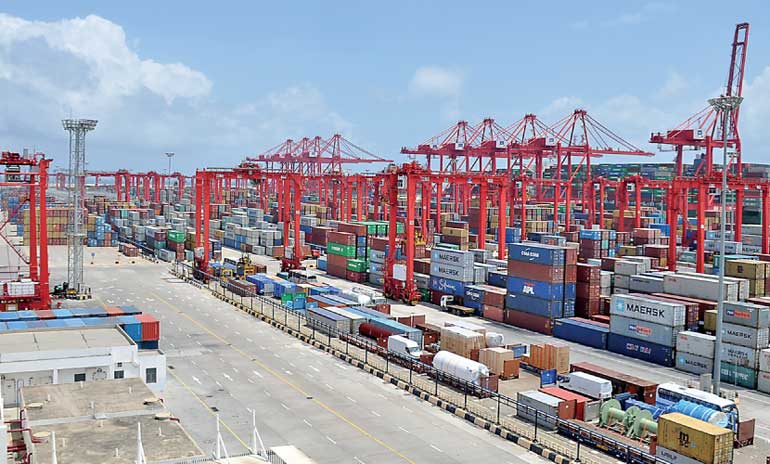Tuesday Mar 11, 2025
Tuesday Mar 11, 2025
Tuesday, 13 June 2017 00:04 - - {{hitsCtrl.values.hits}}
The Government has developed a trade policy. Oppositional groups are developing an alternative policy. Unfortunately, the discussion is not forward-facing. It is difficult to make good policy while looking only at the rear-view mirror. The fixation on trade balances exhibited by some of the professionals engaged in the debate is illustrative.
When people talk about positive or negative trade balances, they quote the easily available data on trade in goods. This may have not have been misleading in the 19th or 20th centuries, but it is now. According to the most recent Annual Report of the Central Bank of Sri Lanka, service exports in the form of labour exports yielded earnings (remittances) of $ 7.2 billion in 2016. Earnings from exports of other services recorded a growth of 11.6% to reach $ 7.1 billion in 2016.
 Drawing conclusions solely from balances in trade in goods is akin to the apocryphal drunk looking for his car keys under a street light – Pic by Lasantha Kumara
Drawing conclusions solely from balances in trade in goods is akin to the apocryphal drunk looking for his car keys under a street light – Pic by Lasantha Kumara
The combined service-export earnings of $ 14.3 billion were larger than the $ 10.3 billion earned from the export of goods. Aggregate earnings from services trade are available, but those between country pairs are less reliable. What does not go through a customs chokepoint is difficult to measure.
Drawing conclusions solely from balances in trade in goods is akin to the apocryphal drunk looking for his car keys under a street light. When asked where he dropped the keys, he pointed to where his car was, elsewhere. He explained that it was dark there, and he could see well where there was light.
Goods trade is just one part of economic relations among countries. One cannot ignore investments. Investment is a form of trade. Governments care about trade balances not for their own sake, but because trade is central to the creation of wealth and employment. When President Trump complains about his country’s trade deficit with Germany, economists point out that he neglects the 700,000 Americans employed within the US by German companies such as BMW and the exports they generate. 
The above example of German-owned companies in the US exporting BMWs from the US to other countries illustrates another weakness of the trade-balance indicator. Nationalists may not be too happy about greater exports being generated by foreign companies. In their thinking, exports are good, but foreign companies doing them may not be. But governments and rational observers need not share this convoluted logic.
True believers in net exports (they used to be called Mercantilists) do not like imports. But they do not understand that imports are necessary for exports, unless what is exported is some natural resource that is shipped out without value addition.
For example, Sri Lanka’s apparel exports depend on a large amount of imports such as textiles, zippers and such. Even tea, our second largest export, depends on the import of fertiliser. Venezuela’s oil exports suffered because imports of critical inputs were blocked. The import restrictions imposed in the 1960s and 1970s in this country killed our exports, in addition to impoverishing our people.
Fixation on trade balances is especially inappropriate in the context of Global Production Networks (GPNs). GPNs encompass firms in many countries engaged in the assembly process at different stages, resulting in multiple border crossings by product fragments before they are incorporated in the final product.
As international networks of parts supply have become firmly established, producers in advanced countries have begun to move the final assembly of an increasing range of consumer durables (e.g., computers, cameras, TV sets, and automobiles) to overseas locations in order to be physically closer to their final users and/or take advantage of cheap labour.
Some observers claim that by 2011 nearly half of world trade in goods and services took place within global value chains. In addition to components crossing and re-crossing borders, modern products are actually complex packages of goods and services. They cannot be assembled if there are restrictions on trade in services. Their assembly is not low cost if there are barriers to imports.
The above illustrates the irrelevance of trade balances in the time of GPNs. But even in the past, trade balances were just an indicator. Country A could run massive negative balances with Country B and not be concerned about them because that country provided a critical input that then helped the firms in Country A to export value-added products to many other countries and run positive trade balances with them that would more than balance out the big negative balance, and so on.
One could look at negative or positive balances as indicative of some problems and seek to fix them. For example, a negative balance may indicate the existence of non-tariff barriers. Or the same fact may indicate the lack of critical elements needed for export from one’s own country. But it would be foolhardy to think of positive balances as policy objectives in and of themselves and negative balances as terrible things. It would be a little difficult to run positive balances with all countries. The EU runs a negative balance with Sri Lanka. But that did not stop them from eliminating tariffs on 6,000 items under GSP+, with the likely result of further increasing the negative balance.
Some get carried away by the statements of politicians, especially the loquacious President Trump. True economists (unlike outliers like Lighthizer, Trump’s Trade Representative) would not base any claims solely on trade balances.
Politicians, even if they were educated in the nuances of international economics, would tend to use easy-to-understand tropes in their persuasive communications. They always need leverage on some issue when dealing with an economic partner. They will talk in terms of negative trade balances that need to be brought down, but the actual conversation is much more complex. Politicians talk about things in certain ways. Professionals who discuss the same things have the responsibility to try to understand the actual phenomena and speak in ways that are more fact-based.
So, let us continue to discuss and debate trade policy. But let us do so based on proper concepts and data. And let us keep our eyes on the road ahead, not the rear-view mirror.
Discover Kapruka, the leading online shopping platform in Sri Lanka, where you can conveniently send Gifts and Flowers to your loved ones for any event including Valentine ’s Day. Explore a wide range of popular Shopping Categories on Kapruka, including Toys, Groceries, Electronics, Birthday Cakes, Fruits, Chocolates, Flower Bouquets, Clothing, Watches, Lingerie, Gift Sets and Jewellery. Also if you’re interested in selling with Kapruka, Partner Central by Kapruka is the best solution to start with. Moreover, through Kapruka Global Shop, you can also enjoy the convenience of purchasing products from renowned platforms like Amazon and eBay and have them delivered to Sri Lanka.
Discover Kapruka, the leading online shopping platform in Sri Lanka, where you can conveniently send Gifts and Flowers to your loved ones for any event including Valentine ’s Day. Explore a wide range of popular Shopping Categories on Kapruka, including Toys, Groceries, Electronics, Birthday Cakes, Fruits, Chocolates, Flower Bouquets, Clothing, Watches, Lingerie, Gift Sets and Jewellery. Also if you’re interested in selling with Kapruka, Partner Central by Kapruka is the best solution to start with. Moreover, through Kapruka Global Shop, you can also enjoy the convenience of purchasing products from renowned platforms like Amazon and eBay and have them delivered to Sri Lanka.